
by Ben Zackheim | Apr 30, 2014 | Book Promotion, Sell your book, Writing |
How important is book genre?
Here’s a worst-case scenario:
1974: Stephen King’s first novel, Carrie, is released. The publisher lists it as a Biography by accident. The book sits on the wrong shelf across the country.
2014: No one knows who Stephen King is.
Yes, that’s an exaggeration, but when you choose the wrong genre for your books on Amazon you’re choosing the wrong shelf. Simply put, that could destroy the book’s chances.
Luckily, we can change genres as often as we change writing software. Every online retailer allows you to genre-hop until you find your right audience.
5 simple steps you can take to choose the right genre:
1) Go to a bookstore!
Okay, this is going to sound trite. If it does, then head to #2. But it worked for me! If your book was inspired by a particular novel or author, then go find them on the shelf.
Now imagine that your book sits next to it.
Does it feel right?
It sounds loopy, but it really works! Especially if your book is a mix of many genres.
Click on the genre you chose in #1 and study the sub-genres on BISG.
Then bookmark BISG! Why? Because new genres pop up every year. The BISG site is the most transparent method of spotting a new mainstream, “official” market for your work.
And guess what? Most booksellers comply with the BISG list!
3) Head to the major online booksellers and find your niche.
These sites are your stores. You get a place on the shelf. You get a small display. You get a few seconds to make the sale. So know your store.
Luckily, with the BISG list you whittled down the choices so you don’t need to dig as much now that you’re about to dive into the morass of online bookstore genre lists! How big a mess are they? Well, here’s the Mystery genre list of four top online stores.
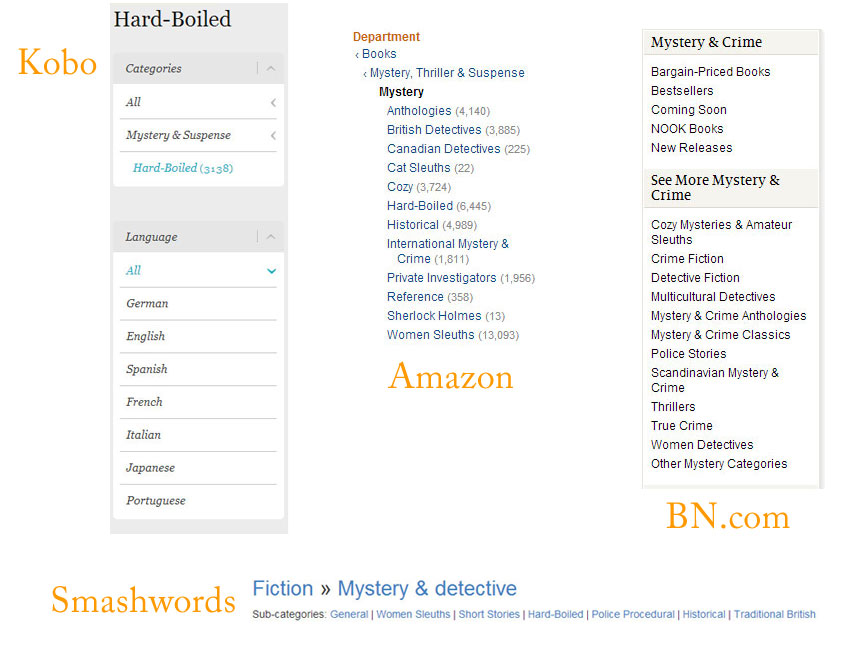
And check out this small taste of what genres each store offers: (all lists are from April, 2014)
Amazon genre list
[showhide type=”genrelist” more_text=”>>Click this link to show the Amazon genre list” less_text=”>>Click this link to hide Amazon genre list” hidden=”yes”]
#s in parentheses are the total number of titles in that genre
Arts & Photography (939,077)
Biographies & Memoirs (691,601)
Business & Money (1,967,372)
Calendars (136,574)
Children’s Books (1,110,182)
Christian Books & Bibles (652,410)
Comics & Graphic Novels (410,241)
Computers & Technology (496,343)
Cookbooks, Food & Wine (187,337)
Crafts, Hobbies & Home (430,882)
Education & Reference (4,512,483)
Engineering & Transportation (710,286)
Gay & Lesbian (52,727)
Health, Fitness & Dieting (610,932)
History (3,805,653)
Humor & Entertainment (453,318)
Law (566,246)
Literature & Fiction (3,178,315)
Medical Books (771,156)
Mystery, Thriller & Suspense (272,265)
Parenting & Relationships (165,447)
Politics & Social Sciences (1,597,281)
Religion & Spirituality (1,271,853)
Romance (435,075)
Science & Math (1,518,315)
Science Fiction & Fantasy (287,324)
Self-Help (309,223)
Sports & Outdoors (254,091)
Teen & Young Adult (279,009)
Travel (414,616)
[/showhide]
Barnes & Noble genre list
[showhide type=”genrelist2″ more_text=”>>Click this link to show the Barnes & Noble genre list” less_text=”>>Click this link to hide the Barnes & Noble genre list” hidden=”yes”]
Art, Architecture & Photography
Bibles & Bible Studies
Biographies
Business & Money
Children’s Books
Computing & Internet
Cookbooks, Food & Wine
Crafts & Hobbies
Education & Teaching
Fiction & Literature
Graphic Novels
Health & Fitness
History
Home & Garden
Humor
Libros en español
Medicine
Mystery & Crime
Nonfiction
Politics & Current Events
Psychology
Religion
Reference
Romance
Science & Nature
Science Fiction & Fantasy
Self-Improvement
Sports & Adventure
Travel
[/showhide]
Kobo genre list
[showhide type=”genrelist3″ more_text=”>>Click this link to show the Kobo genre list” less_text=”>>Click this link to hide the Kobo genre list” hidden=”yes”]
BIOGRAPHY & MEMOIR
Artists, Architects & Photographers
Business
Composers & Musicians
Entertainment & Performing Arts
Historical
Literary
Philosophers
Political
Reference
Religious
Royalty
Sports
BUSINESS & FINANCE
Accounting
Business Reference
Career Planning & Job Hunting
Economics
Entrepreneurship & Small Business
Finance & Investing
Human Resources & Personnel Management
Industries & Professions
Management & Leadership
Marketing & Sales
Personal Finance
COMICS & GRAPHIC NOVELS
Anthologies
Contemporary Women
Crime & Mystery
Erotica
Fantasy
Gay & Lesbian
Historical Fiction
Horror
Literary
Manga
Media Tie-In
Non-Fiction
Religious
Romance
Science Fiction
Superheroes
FICTION & LITERATURE
Action Suspense
Anthologies
Classics
Drama
Essays & Letters
Fiction – Young Adult
Historical
Horror
Humorous
LGBT
Literary
Literary Theory & Criticism
Movie & Television Tie-Ins
Poetry
Psychological
Religious
Short Stories
Thrillers
Westerns
KIDS & TEENS
ABCs, 123s
Animals
Beautiful and Interesting
Comics, Graphic Novels & Manga
Creative Kids
Fiction
Français, Español and more
Knock knock, Who’s Funny?
My Family, My Feelings, My Friends
Natural World
People and Places
Read-Along
Religion
School Tools
Sports and Recreation
Technology
Teen
Two Wheels, Four Wheels, No Wheels
MYSTERY & SUSPENSE
Cozy Mysteries
Espionage
Hard-Boiled
Historical Mystery
International
Legal
Police Procedural
Technological
Thrillers
Traditional British
Women Sleuths
NONFICTION
Art & Architecture
Computers
Entertainment
Family & Relationships
Food & Drink
Health & Well Being
History
Home & Garden
Reference & Language
Religion & Spirituality
Science & Nature
Social & Cultural Studies
Sports
Travel
ROMANCE
Contemporary
Erotica
Harlequin
Historical
Inspired Romance
Paranormal
Romantic Suspense
Science Fiction & Fantasy
SCI FI & FANTASY
Fantasy
High Tech
Historical
Horror
Science Fiction
Space Opera
Steampunk
[/showhide]
Smashwords genre list
[showhide type=”genrelist4″ more_text=”>>Click this link to show the Smashwords genre list” less_text=”>>Click this link to hide the Smashwords genre list” hidden=”yes”]
Fiction
Adventure
African American fiction
Anthologies
Children’s books
Christian
Classics
Cultural & ethnic themes
Drama
Fantasy
Gay & lesbian fiction
Graphic novels & comics
Historical
Holiday
Horror
Humor & comedy
Inspirational
Literary collections
Literature
Mashups
Mystery & detective
Poetry
Romance
Science fiction
Themes & motifs
Thriller & suspense
Women’s fiction
Young adult or teen
Non-Fiction
Antiques & Collectibles
Art, Architecture, Photography
Biography
Business & Economics
Career Guides
Children’s Books
Comics (nonfictional)
Computers and Internet
Cooking, Food, Wine, Spirits
Education and Study Guides
Engineering, trades, and technology
Entertainment
Gay and Lesbian
General reference
Health, wellbeing, & medicine
History
Home and Garden
Inspiration
Language Instruction
Law
Music
New Age
Parenting
Philosophy
Politics and Current Affairs
Psychology
Publishing
Reference
Relationships and Family
Religion and Spirituality
Science and Nature
Self-improvement
Sex and Relationships
Social Science
Sports & outdoor recreation
Transportation
Travel
True Crime
Weddings
[/showhide]
The lists above don’t include all sub-genres! So yeah, there are a lot of options. Again, BISG will help you focus.
4) Choose every single genre that makes sense.
Every. Single. One.
That’s probably a lot, and that’s okay. Write the list down somewhere safe. You’ll need it for #5.
Each online seller allows you to choose a different number of genres. Choose the genres that feel right. Or choose the genres that solid data supports.
Important note: Make sure your honest with yourself and choose a genre that actually fits. Just because your book includes a cameo of a handsome vampire doesn’t make it a New Adult Paranormal Romance. If you choose the wrong genre for your book you will hear from the readers — with bad reviews (see #5 for my experience).
Important note #2: Some bookstores don’t allow you to choose the precise genre you want. In this case, write to their support team and tell them you’d like placement in a certain genre. They’ll do so, but it may take a while.
5) Measure performance and make changes
This might be controversial advice, but it makes sense. If you don’t think your book is finding an audience in the genre you picked, then consider changing to another one.
[blockquote author_name=”” width=”50%” float=”left”]Upside: You might hit the nail on the head.[/blockquote]
[blockquote author_name=”” width=”50%” float=”left”]Downside: You might disrupt any momentum you were getting in the genre (which is info that none of these stores shares with us).[/blockquote]
I changed genres for the Shirley Link series on Amazon from Young Adult Mysteries to Kids Mysteries. I was getting a lot of downloads in Young Adult, but most of my reviews were *enh* to awful because young adults thought my books were too young for them. While I haven’t yet shown in the top seller list on Kids Mysteries, I’ve seen excellent reviews since I made the move.
It’s a tough call, sure. But if your book isn’t moving after a couple of months, try changing one of your sub-genres before you spend cash on a promo.
What tips do you have for genre seekers? Help out a fellow writer in the comments.
By Ben Zackheim
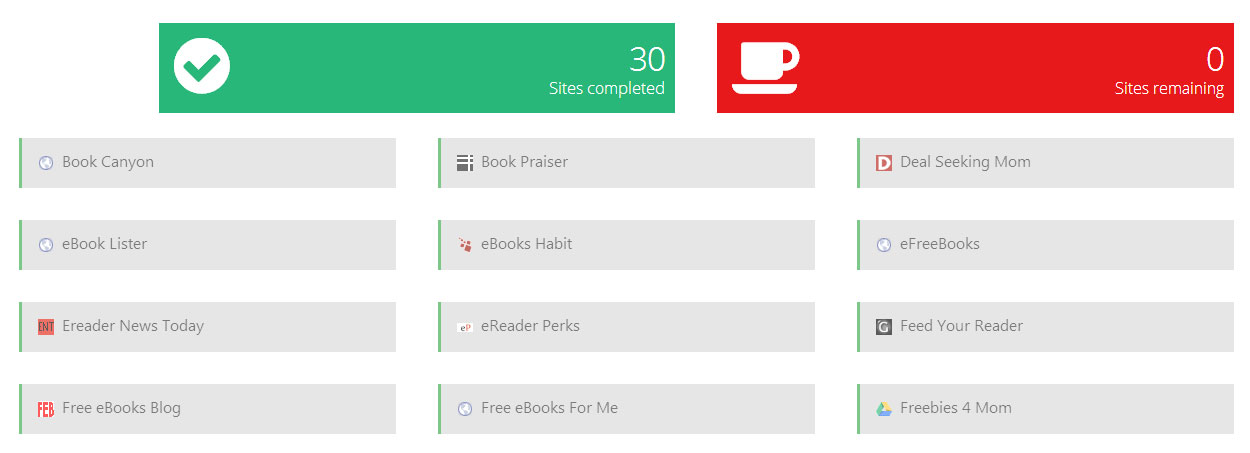
by Ben Zackheim | Apr 23, 2014 | Book Promotion, Sell your book, Writing |
As usual, I’m at my standing desk doing squats (poorly). I’m in the throes of marketing bliss as I find ways to promote my book.
I check on the sales of my book Shirley Link & The Black Cat.
They’re dip-tastic.
Time for a promotion.
So I plan until my brain stem hurts: the right day, the right level of social sharing, the right promotional materials… You know the drill.
Now all I have to do is post my book to the book listing sites! Wheee! So let’s see. That means I get to…
… scour through my bookmarks to find sites that still exist.
… excavate the correct submission page and read through the site rules that run, on average, 4,987 words.
… enter the same information over and over until I hate my name/book title/genre/sub-genre/description…
Of course, even with all of this work, there is no guarantee that my book will actually appear on the promotional site.
Can I lick the floor instead?
So when I heard about Book Marketing Tools’ ebook submission tool I stopped doing my lame squats. Book Marketing Tools promises to let you easily promote your book on 30 of the top free/deal sites. How easy? Like one-click per site. Fifteen minutes from start to finish.
This isn’t like Authors Marketing Club’s tool where they list out the links and send you off to fill out the form to promote your book. It’s a service that promises to make the submissions easy. That’s a promise I’m delighted to take them up on.
How does the ebook submission tool work?
I headed in with high hopes and low expectations. I’ve been burned by promotional tools before.
So I was pleased to find a good-looking site that told me what it did and got me into work-mode fast. The service asks you to enter some basic data about you and your book. It’s the same info you’re usually asked to enter on the deal sites. ASIN, Title, Author, Genre, Author bio. The idea here is that you should only need to enter the data once for all 30 sites.
When you finish with that step, you get this…
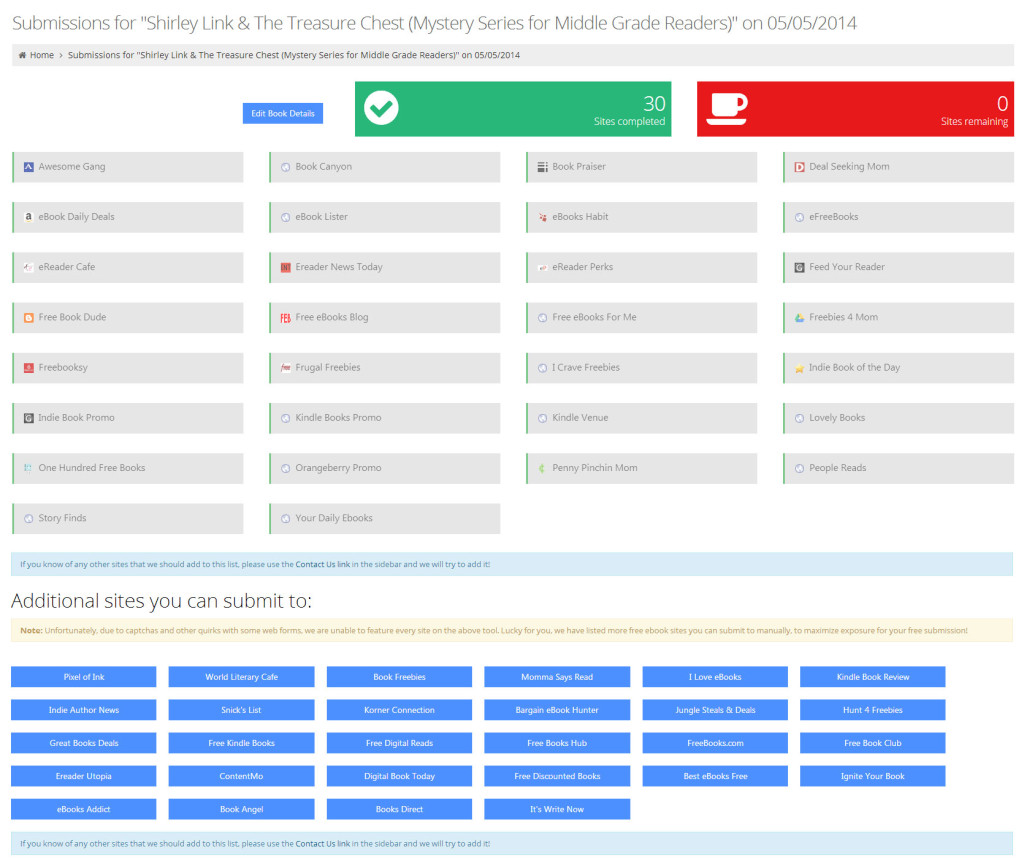
See the list of sites with the light gray backdrops? Those are the ones that you can submit to automatically. All you have to do is click on the first site (Awesome Gang) and a pop-up window appears. You verify the pre-populated info and click on the ‘Next’ button.
Repeat 29 times.
Did it work? Yup. Some of the steps required an extra few seconds of data entry, but the process took only 15 minutes! Fifteen minutes to promote your book on 30 sites. Wow.
I think my favorite part was watching dozens of verification emails flood my inbox one after another.
Unfortunately, the blue-button sites at the bottom of the dashboard screen cannot be filled automatically. They act more like the AMC tool — sending you off to the correct submission pages where you do the heavy lifting. Still, it’s nice to have the list in one place.
With all of its strengths, I’d like to see the tool track two things:
1) Which of the sites under the “Additional sites you can submit to” header did I submit to already? I’d like to check it off my list once I’m done submitting manually.
2) What’s the success rate of the submissions? Did Edreader News Today show my book on promo day, or not? I’d use this service to track my progress if it had the tools.
But won’t the submission sites be angry about this new service? Not if they think it through. I discovered a bunch of sites I’d never heard of before on the dashboard. Besides, when I submit to a promo site I’m not there to browse. I want to submit my book and move on. That’s not the behavior of a valuable visitor. In my opinion, promotional sites should work with Book Marketing Tools to make things as easy as possible for us. It’s a logical way to strengthen their services and their brands.
So yes, the ebook submission tool can help you promote your book to 30 sites in 15 minutes, as advertised. If I could track details of my promotions then Book Marketing Tools could become one of my default browser tabs.
The price is $29 per book promo. That seems a little steep to me, but I might do it to save myself a couple of hours of work.
Give it a try and let us know how it works for you.
By Ben Zackheim
Disclaimer: Book Marketing Tools reached out to me and offered me a $5 credit to test their new tool. I’m posting my experience, which was a good one.

by Ben Zackheim | Apr 22, 2014 | Book Promotion, Digital Identity, Sell your book, Writing |
Isn’t it fun to write about yourself? Wouldn’t you love to make a career out of coming up with new ways to talk about how interesting you are? Me neither.
Can author bios sell books? If you believe that a great cover, glowing reviews and a spot-on book description can sell books, then you’ll believe me when I say yes. The author bio is a featured data point all over the web. If a reader loves your bio, then imagine what they can get out of an entire book! Yeah, author bios sell books.
The fact is, author bios are the best way to make yourself compelling to a complete stranger who’s thinking about buying your book. Very few authors over the years have enjoyed crafting bios. But we still need them.
And we need to write more of them! For example, you need to tailor unique bios for your marketing efforts. Blogs, newsletters, deal sites, listings… many of them want a unique bio and book description when you submit. It’s frustrating but it makes sense. They don’t want their audience (or Google) to see them as redundant.
So here are some best practices that I’ve discovered on my journey. They’ve saved me time. They’ve made promotion just a tad bit easier just when I needed it most. And they’ve sold a few books!
Author bio tip 1. Your bio isn’t about you. It’s about your audience. Okay, technically that’s not true, but think about it. You’ve caught someone’s attention! That’s a big win! Don’t lose it by taking your eyes off of your goal here.
So make the bio appeal to your target audience. If that means showing off your snappy, friendly and entertaining self to sell your kids book, then cool. If you’re going for insightful, deep and intelligent for your paranormal romance then let it fly.
But please, whatever you do, don’t neglect your bio. It’s not below you. Some readers consider it a key part of their decision to buy, so treat your bio with the respect it deserves.
While all five of these tips will help you make a better bio, tips 2 and 3 are the best advice for how to write an author bio that sells books.
Author bio tip 2. Write the bio for the site where it will live, and mention your reading interests. As I’ve advised before, you should dig into the online store that you’re selling on. Even a smattering of research can yield insights that will help focus your bio.
What kind of books do you enjoy? Mystery? On Amazon you get the following drop-down results when you type that term in the search window:

On B&N:

My advice for this genre is to mention you like “mystery series” on your B&N bio. Mention you enjoy “mystery books” or “mystery and thriller” on your Amazon bio.
See what I’m doing there? I’m leveraging the site’s search engine to tell me what customers search for. All the terms that you see in the drop-down are arranged by popularity, so it’s great info that you can use to connect with readers.
I’ve written on this method of finding your target audience before, so I won’t belabor the point.
But one last thing, don’t get bogged down on this step. Really, what you should do is…
Author bio tip 3. Be passionate. When you write about your passions, your writing gets better. So mention your passions — hobbies, family, travel stories. It will help you connect with the reader.
Author bio tip 4. When you do finally get in the mood to hammer your way through your author bio, don’t just write one! Hey, you’re on a roll, so take advantage. Write five to ten quick and dirty bios that you can adjust later. Keep it in one file, somewhere safe. Then when you run into one of those sites that requires you to give them a unique author bio, you’ll have some fresh ones to choose from. Tighten it up and you’re done.
Author bio tip 5. First or third person? Great question. More independent authors are choosing first person. I think the reason for this is two-fold. One, it’s more comfy. Two, they want to convey their brand in a more casual way.
The counter argument is “first-person is amateurish and third person is professional.” The bios you read on books in the bookstore are rarely in first person, after all.
But I think most bios sound dull. And I’ll bet they’re dull because they’re written by authors who aren’t comfortable writing about themselves in the third person. Or they’re written by a hired hand who doesn’t know the author. Either way I lean toward first person myself because that’s what comes naturally.
How about you? Go ahead and paste your author bio in the comments section. We’d love to hear your thoughts on how to write an author bio that sells books!
By Ben Zackheim

by Ben Zackheim | Apr 13, 2014 | Book Promotion, Sell your book, Writing |
We need to eat. Forget it.
We need to go pee. We won’t.
We need to sleep. Yeah, right.
Writers go from one discomfort and life-draining behavior to another when we work on our stories. But then comes the dreaded moment when we must write a book description.
Suddenly the pain is too much to bear.
Most of us choke. But why? Maybe we feel that explaining the book will make it sound so bad (to us) that we’ll question why we even began writing it in the first place?
The problem with such a bad habit is this.
The fourth most important step to sell books online is the book description.
Fourth, huh? How do I figure that?
1) Write a great (professionally edited) book.
2) Have a great cover.
3) Put a few glowing reviews directly above the…
wait for it…
4) Yup. The book description.
The reader will know they’re on to something special when they spot a cool cover and enthusiastic responses from real readers. But the book description is where you’ll either close the sale or lose them. That means you need to treat it with the same respect you showed your story.
I want to talk about some critical steps we can all take to craft the best possible book description. And at the end of the post I want to share a new idea I had. I’m trying it out now and I think you should too.
Why is a great book description important?
Let’s first define what I mean by a “great book description.”
A great book description will help you sell books.
That’s why it’s so important. So for this post we’ll be honing in on the actual sale like a (super-friendly!) sniper.
Be warned. Part of what I’m talking about is number-crunching. Part is craft. There may even be some art to it. But the goal here is to give you all the info you need to produce an effective book description that sells books.
So. Rubber, meet Road.
How to write a book description that sells books
Tip 1:
Get reviews before you launch your book. What do reviews have to do with a good book description? We’ll get to that in a sec.
Reviews should live right above your product description. Don’t rely on the retailer’s reviews section to sell books. They build their product pages to sell a variety of products, not just books. Book pages need testimonials in a clear and obvious place — just like the back cover and flaps of real books.

Tip 2:
Using the reviews, craft your description. Show the potential buyer just how right the reviewers are! Act as a mirror to a couple of the key terms/phrases that your reviews use. If a review calls your book “an enlightening romp through one man’s middle life” then you can verify that in the book description by using words like “enlighten” and “middle life.” It’s a great way to subtly say, “That reviewer is so right!”
Tip 3:
The first sentence should be as good as your book’s first sentence. Remember how you pounded on the first sentence of your book until it was just right? Do that with your description too.
Tip 4:
Use terms that the online retailer’s search engine will love. Yes, we’re getting into uncomfortable territory here. Where’s the art in all of this, Ben? That’s up to you to find. But I’m obligated to tell you that Amazon scans your book description for terms that help its search engine find your product.
So be sure to include terms that reflect the genre you’ll be placing the book in. If your book is the story of a reporter investigating the death of her cousin at the hand of a serial killer at the start of World War II, then be sure you include terms like investigative journalism, World War II and serial killer in your description.
By the way, that’s my mom’s book, The Last Train to Paris. Go Mom!
There’s a cool way to check on what terms Amazon readers like to search for. Just use Amazon search! Enter a term that applies to your book. You’ll see a whole bunch of suggestions. Amazon is essentially telling you that these terms are what their readers are searching for. Use that to your advantage and find a word or term that’s a good fit. Choose a couple and put them in your book description.

So I should advise my mother to include the terms World War 2 historical fiction in her description. It’s appropriate to her book and it ranks high when people begin to type “Word War 2”. Of course, being my mother, she will ignore my advice.
Tip 5:
Target the shopper, not the reader.
Aren’t they the same? Probably, but not necessarily. I learned as a writer of books for young people that the book description must appeal to the adult who’s buying the book. Not the kid who’ll read it. A cousin of mine, Nerissa Nields, wrote a book that has “gift” written all over it, titled How to be an Adult. Yeah college graduates’ parents might want to jump on that one.
Tip 6:
Test! Post the description to your favorite online hangouts and ask for feedback. Send an email to trusted resources. Yes, that includes family and friends, as long as they have a good track record for giving constructive criticism.
I’ve found the community for BookGoodies on Facebook and the Createspace forums to be packed with people who love to give useful feedback.
If you’ve read this far then you might want me to cut to the chase and just get to this “new idea” I mentioned earlier.
Here it is…
Tip 7:
Don’t write an excellent book description. Write two excellent book descriptions.
Why?
The first will be for your launch audience. The second will be for the long-run.
What’s a launch audience? It’s the audience you know you have access to from the get-go. It can include your email list, your Facebook followers, etc. Did you read my post about Twitter analytics that help you identify your target audience? In a nutshell you can use Twitter to find out the specific interests of your followers. If you can identify specific interests of your followers then you can use words and terms that resonate with them.
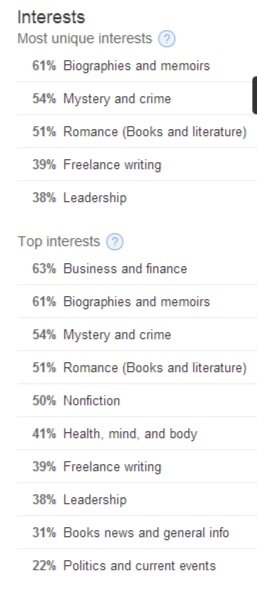
Yup. That’s a breakdown of my Twitter follower’s interests.
Go read the post. It lays out just how incredible this data is. It’s key to our never-ending quest to reach people who might be interested in our books. I wish Facebook offered the same robust insights, but they took the opportunity to charge us for targeted marketing.
Tip 8:
Tweak! Never stop adjusting the book description of your books. The beautiful thing about self publishing is that it allows you to make fast adjustments based on good data. If your book is suddenly newsworthy because of world events, then by all means head in and edit it! If a new term starts catching on that applies to your book, use it! You get the idea.
Conclusion:
A book description isn’t some alchemical element that could blow up in your face if you call forth the wrong incantation. It also won’t work if you just write, “Me book be gooder than your thinking it could of!” Find a process that works for you. Use your talent to write and use your curiosity about your audience to dig into what will make them more likely to click the Buy button.
By Ben Zackheim
Note: This post contains two affiliate links (in Tips 4 and 5), both of which are links to books on Amazon. One book is by my cousin, the other book is my mother’s. They’d better be fine with this, or Thanksgiving is going to be very uncomfortable this year.
[divider divider_type=”gradient”][/divider]
You might also like:
Amazon has a bridge to sell ya!
The $1.1 Million question: Is KDP Select worth it?

by Ben Zackheim | Apr 8, 2014 | Book Promotion, Digital Identity, Sell your book, Shirley Link & The Treasure Chest, Writing |
You hear the one about the two authors who walk into a bar? One has a mailing list. The other one has zip. Nada.
Mailing List: “I saw that tweet about your book sale the other day.”
Zip Nada: “Yeah. I got two whole sales after a week of prep, a $50 ad spend on Goodreads and 28 tweets.”
Mailing List: “Wow. That sucks.”
Zip Nada: “Thanks. That’s really helpful. I got your newsletter about your book last month. Looked nice.”
Mailing List: “50 copies sold. Not too bad. Why don’t you use your email list to promote sales?”
Zip Nada: “I don’t have one.”
Mailing List: “Oh man! It took me seven years to build mine! You’d better get started, like yesterday!”
What’s the punchline of the joke? Zip Nada punches Mailing List in the face.
If a writer doesn’t have an email list, does he make a sound when he falls in the forest?
Many writers experience dismal sales from Twitter/Facebook/[enter social network name here]. A common complaint is, “My followers are family, friends or fellow writers who don’t buy other writer’s books.”
We’re told that we should have an email list. That way we can reach the highest quality, most targeted audience possible.
Uh. I’m afraid all the above is true.
But…
Here’s some great (and little-discussed) news. If you use Twitter then you can reach your target audience. No matter what the “quality” is of your followers!
How?
Twitter Analytics, is a spectacular tool for finding people to buy your book.
You could say, “but that assumes my social network followers care about my books and they demonstrably do not.” This is a big misconception,and probably one of the most damaging to authors who blog, tweet and share online. We’re told by a lot of smart people out there that people who follow us, Like our posts or share our tweets aren’t necessarily fans, or even readers.
That’s a glass half empty (and incomplete) perspective.
Here’s mine:
The Twitter connections we’ve made online with non-fans and even non-readers are valuable enough to sell books.
How can that be? Because Twitter has learned so much about them!
Here’s what I mean. This is a breakdown of my Twitter following.

Is that a marketer’s ten thousand dollar breakdown of potential audience?
No, it’s Twitter’s free report on my followers.
Yup. They actually tell me what interests my followers have, even broken down by favorite genres! So for all my Twitter struggles and misses and successes over the years, in the final analysis it was my mere presence that gave Twitter the data it needed to say, “Hey, good job reaching out. Here’s who you have. Now go have fun selling your book to them!”
How does this help you? If you look at your own follower breakdown you’ll spot interests and terms that you can tweet about. For instance, using the data above, I just brainstormed a new tweet that I’m going to try:
Tweet: How do teenagers learn #leadership skills? Shirley gets crash course in #mystery Shirley Link & The Treasure Chest http://ctt.ec/n4z2o+
In that book, my heroine (Shirley Link) gets a lesson in leadership when she tries to get her two best (and bickering) friends to work together. All while dragging her dad around so he can help with the case.
So I’ve used two terms that I know (from solid Twitter data) will resonate with a huge part of my Twitter following: “mystery” and “leadership”.
But it doesn’t end there. You could apply this data to find terms for your book description, your book metadata and even blog posts about your book. Then when your audience clicks on the tweet they’ll see their favorite subject brought up again and again as they decide if they want to buy or not.
Conclusion: Get signed up for Twitter Analytics to find your target audience
So the lesson here is, you might not have a big enough mailing list yet. But as you build that up, don’t fret. Use Twitter and some common sense and you’ll find your readers.
Sign up for Twitter analytics here.
by Ben Zackheim
If you liked this post, give these a try!
WordPress for authors and writers (part four)
WordPress for authors and writers (part three)
WordPress for authors and writers (part two)
WordPress for authors and writers (part one)
Top 5 writing contests

by Ben Zackheim | Mar 26, 2014 | Book Promotion, Writing |
Goodreads giveaways are a wonderful way for authors to reach potential readers. Why? Because when you give away your book on Goodreads, you’re placing all of your hard work in the hands of someone who wants your book and wants to enjoy it. That last part of the sentence is important. Everyone knows that Goodreads is filled with readers. But one of the unspoken benefits of Goodreads is that people on the site are predominantly kind and supportive. Yes, there are exceptions. But people want to enjoy the books they read. This means you’ll find readers and they’ll be on your side from the get-go.
When you give away a book it’s different than giving away an app, for instance. Books speak to our hearts, minds, senses, emotions. By giving away our story we’re already ahead of the mad rush for people’s hearts that other businesses strive for.
The second biggest benefit of Goodreads giveaways is powerful. If you’re giving away a pre-release book, Goodreads will email many of the contest entrants with news of your book launch. More on that below.
Before you can tackle any of the steps here, you’ll need to sign up to be a Goodreads Author.
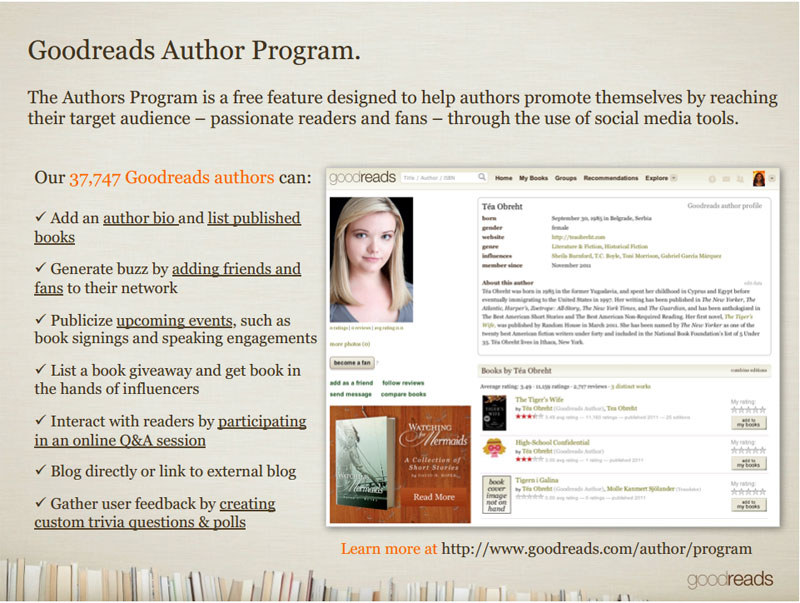
This requires you to have a book in their system. You can add your book easily. Just make a simple request to a Goodreads Librarian.
So once you’re an author with work on the site, here’s how you set up Goodreads giveaways:
1) Go to www.goodreads.com and sign up or sign in
2) Click on Explore in the upper right. Then select “giveaways”.
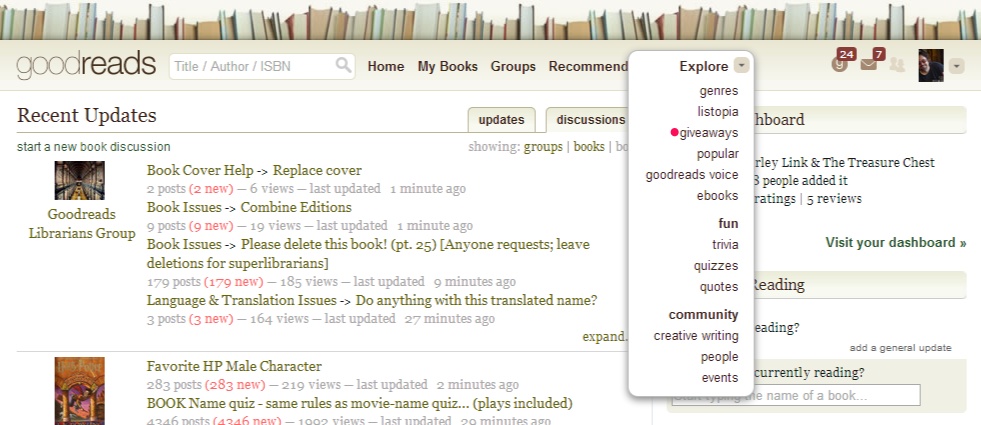
3) You’ll see a list of current giveaways. If you’ve signed up as a Goodreads Author you’ll see “List a Giveaway”. Select it.
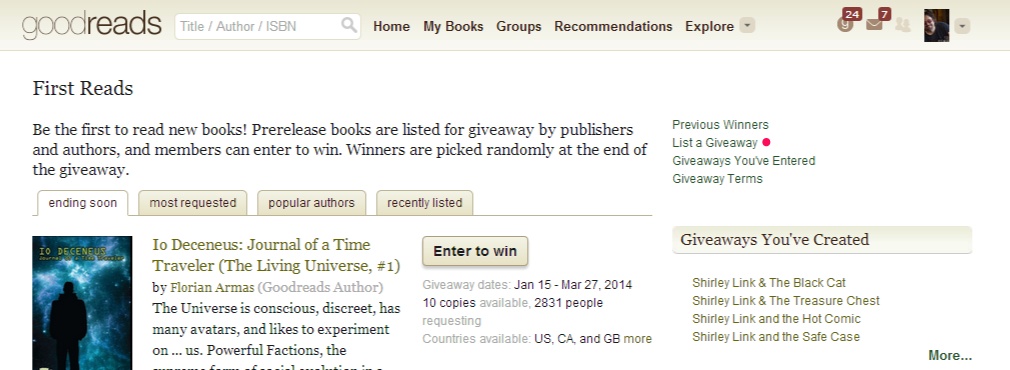
4) Here’s the listing page at last!
Look below the image to get the run-down.
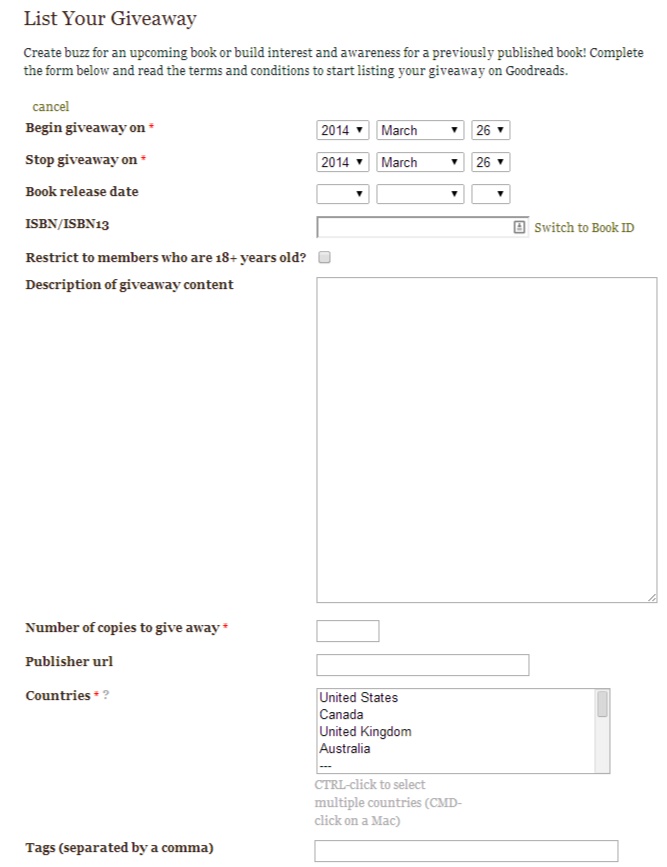

The “gotchas” and best practices are as follows:
-
Be sure to make the contest last a full month. Any less and you’re missing out on potential readers. In general, you’ll see the hugest spike in entrants as the contest deadline approaches, so fret not if things start slow!
-
Try to do the contest a full 2 months before the book launch. So when the contest ends you’ll still have a month to get feedback and reviews from your winners. And they’ll feel special that they got a book a month before it came out.
-
Enter your ISBN or ISBN13 in the field. If you only have an ASIN (Amazon’s ID format) then click on the “Switch to Book ID” link on the right side of the text entry field.
-
Make the description a kick-ass, direct pitch. The better the description, the more entrants you’ll get, guaranteed.
-
Goodreads likes to have authors give away 50 books. I agree that it’s a good number if you can afford it. I’ve done 10 and been happy with the results. However, I plan on following their advice with my next giveaway for The Camelot Kids. 50 copies, here I come!
-
If you don’t have a publisher then just enter your own site’s url. If you don’t have a site, please build one.
-
Choose the countries where you think your book will resonate. It’s a pain to send books internationally, but worth it if you can grow your global readership.
-
Tags are a whole post unto themselves. Enter terms that you believe apply to your book. You can use genre terms (horror, scifi), popular terms (Sherlock, Chicago Bears) or whatever comes to mind. The tags will help entrants choose the book that’s right for them.
-
The contact info is just asking you for basic info. Don’t worry about it. Just write something like “[Name], [email]. I’m the author of the book, [book name]
-
You can include an excerpt of your book for entrants to read. I’d advise doing this because the more people who enter who really WANT to win your book, the better your buzz will be.
Agree to the terms. They’re perfectly reasonable. Here they are for your convenience:
-
You agree to supply the indicated number of books on the date the giveaway ends.
-
Goodreads will list (for free) the giveaway book on the giveaways page.
-
Goodreads will collect interest in the book, and select winners at our discretion. Our algorithm uses member data to match interested members with each book.
-
After the giveaway stop date, click the name of your giveaway (listed under “your giveaways” on the main First Reads page) to see the list of winning addresses. You will also be emailed a list of winners. You are responsible for shipment of the books. Failure to do so will result in us not inviting you over for cake ever again.
-
You agree not to store the winners’ mailing addresses and not to use the winners’ addresses for anything other than sending them the indicated book.
-
Winning members are encouraged but not required to write a review of the book they receive.
-
Ebooks are not allowed. Every winner must receive a physical copy of the book.
Once you’ve started the contest you can retrace Steps 1-3. Notice the area on the right-hand side of the page that reads “Giveaways You’ve Created”? That will give you quick access. You can also find the contest listed on your Goodreads Dashboard
Now here’s the wonderful part. Everyone who enters your Goodreads giveaway will be opted-in to receive an email from Goodreads on the release date. That’s why they ask for the launch date of your book on the form above! In my experience about 75% of the entrants stay opted in.
That’s it! Now you need to promote the contest. That includes posting the Goodreads giveaway on linky (contest) sites and, yes, leveraging Goodreads advertising. I’ll post about that soon.
The final bit of usefulness comes from Goodreads itself. This slideshow is gold.
You might also find the following posts useful:
Does advertising on Goodreads work?


















